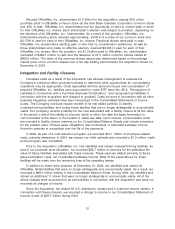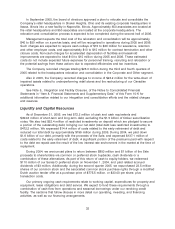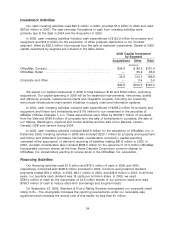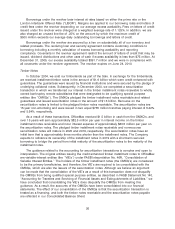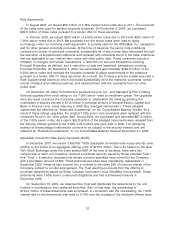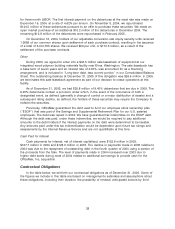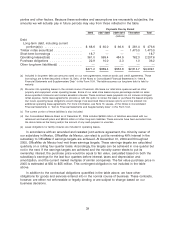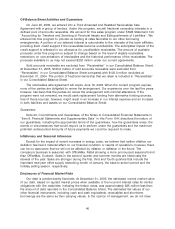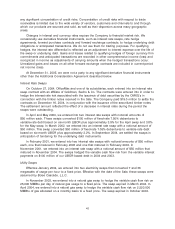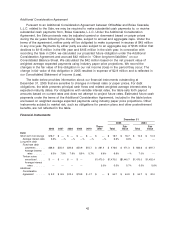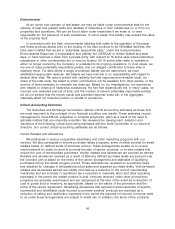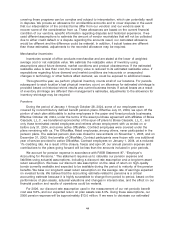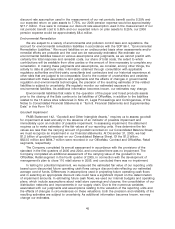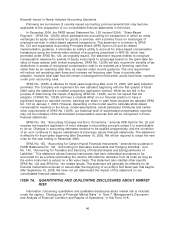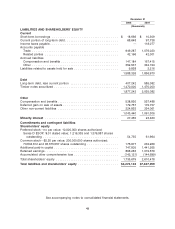OfficeMax 2005 Annual Report Download - page 45
Download and view the complete annual report
Please find page 45 of the 2005 OfficeMax annual report below. You can navigate through the pages in the report by either clicking on the pages listed below, or by using the keyword search tool below to find specific information within the annual report.any significant concentration of credit risks. Concentration of credit risks with respect to trade
receivables is limited due to the wide variety of vendors, customers and channels to and through
which our products are sourced and sold, as well as their dispersion across many geographic
areas.
Changes in interest and currency rates expose the Company to financial market risk. We
occasionally use derivative financial instruments, such as interest rate swaps, rate hedge
agreements, forward purchase contracts and forward exchange contracts, to hedge underlying debt
obligations or anticipated transactions. We do not use them for trading purposes. For qualifying
hedges, the interest rate differential is reflected as an adjustment to interest expense over the life of
the swap or underlying debt. Gains and losses related to qualifying hedges of foreign currency firm
commitments and anticipated transactions are recorded in other comprehensive income (loss) and
recognized in income as adjustments of carrying amounts when the hedged transactions occur.
Unrealized gains and losses on all other forward exchange contracts are included in current-period
net income (loss).
At December 31, 2005, we were not a party to any significant derivative financial instruments
other than the Additional Consideration Agreement described below.
Interest Rate Swaps
On October 27, 2004, OfficeMax and one of its subsidiaries, each entered into an interest rate
swap contract with an affiliate of Goldman, Sachs & Co. The contracts were entered into in order to
hedge the interest rate risk associated with the issuance of debt securities by the OMXQ’s in
connection with the timber notes received in the Sale. The Company paid $19.0 million to settle the
contracts on December 16, 2004, in conjunction with the issuance of the securitized timber notes.
The settlement amount reflected the effect of a decrease in interest rates during the period the
swaps were outstanding.
In April and May 2004, we entered into two interest rate swaps with notional amounts of
$50 million each. These swaps converted $100 million of fixed-rate 7.50% debentures to
variable-rate debt based on six-month LIBOR plus approximately 3.9% for the April swap and 3.8%
for the May swap. In March 2002, we entered into an interest rate swap with a notional amount of
$50 million. This swap converted $50 million of fixed-rate 7.05% debentures to variable-rate debt
based on six-month LIBOR plus approximately 2.2%. In September 2004, we settled the swaps in
anticipation of tendering for the underlying debt instruments.
In February 2001, we entered into two interest rate swaps with notional amounts of $50 million
each, one that matured in February 2003 and one that matured in February 2004. In
November 2001, we entered into an interest rate swap with a notional amount of $50 million that
matured in November 2004. The swaps hedged the variable cash flow risk from the variable interest
payments on $100 million of our LIBOR-based debt in 2004 and 2003.
Utility Swaps
Effective January 2004, we entered into two electricity swaps that converted 7 and 36
megawatts of usage per hour to a fixed price. Effective with the date of the Sale, these swaps were
assumed by Boise Cascade, L.L.C.
In November 2003, we entered into a natural gas swap to hedge the variable cash flow risk on
25,000 MMBtu per day of natural gas usage to a fixed price. The swap expired in March 2004. In
April 2004, we entered into a natural gas swap to hedge the variable cash flow risk on 2,520,000
MMBtu of gas allocated on a monthly basis to a fixed price. The swap expired in October 2004.
41


